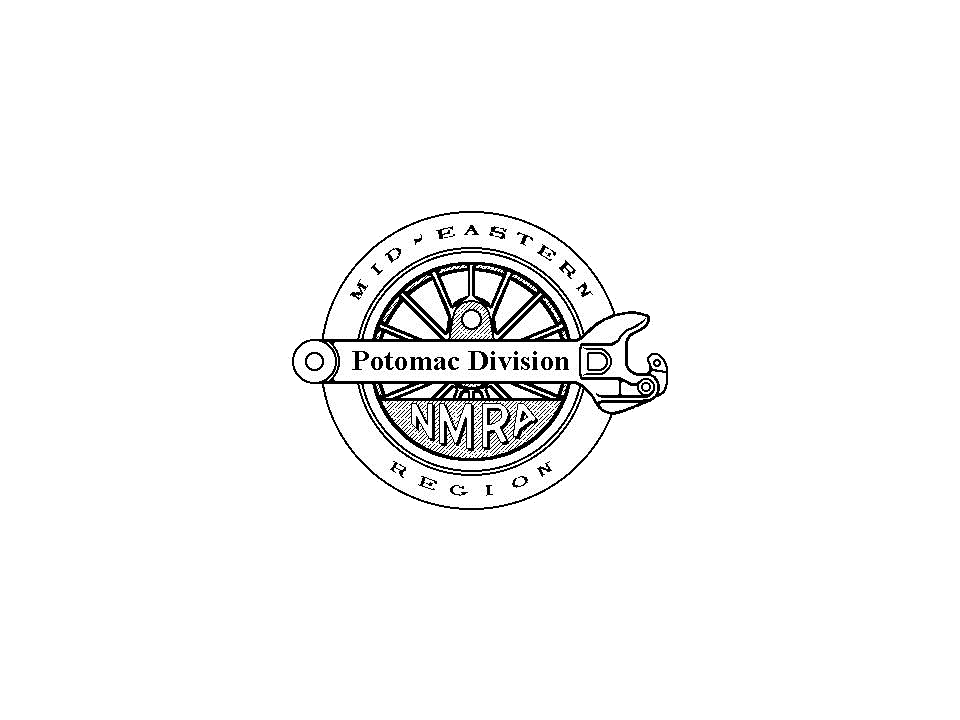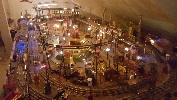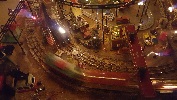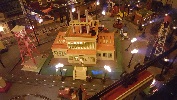Bruce
Greenberg’s Bessley Railroad
By
Gary Mason
Confession:
I’d
become accustomed to the modest sound of an HO scale train
running on track atop cork roadbed. So when I visited Bruce
Greenberg’s Bessley Railroad during the Potomac Division’s May 5
layout tour, I was not prepared for the decidedly louder,
unmistakable sound of its standard gauge equipment running on
steel rails and clickety-clacking over the rail joints. The
Bessley’s distinctive sound immediately brought to mind the O-27
Lionel train my father would set up around the base of our
Christmas tree in the early 1960s. But the reminiscences
didn’t stop there. The pale green of the massive arched
span of Lionel’s pre-World War II tinplate Hellgate bridge, as
well as on the roof, windows and cornice of the otherwise cream
colored passenger station vividly brought back many iconic
memories from my youth which, together with growing up in a
small railroad town in northern California (on the Northwestern
Pacific RR), put me on the path to becoming a model railroader.
Bruce’s
Bessley Railroad has done what any good train layout of similar
age should: it has continued to evolve and improve.
Originally constructed in the 1980s as an 8’ by 16’ 1:30 scale
(standard gauge) exhibition layout for Bruce and his wife
Linda’s Maryland-based Greenberg’s Great Train and Toy Show
(which continue to this day), after many miles, shows, and
exposing thousands of mostly North Easterners to model trains
now comfortably resides with the Greenbergs in Alexandria,
VA. Retired from the road, by 2010 the layout had already
come to include three additional operating tracks (including
street running traction). It also began increasing in
detail -- with additional structures, vehicles and other
elements benefitting its more sedentary habit. Along the
way it also became host to a previously marketed motorized O
scale truck that traverses its own “street.”
Beginning
in
2013, in addition to being formally bestowed its’ road name, the
Bessley left the realm of an “at grade” layout with the
additions of first one, and then a second even-higher, elevated
monorail. An elevated 0-27 scale trolley line was even erected
as the layout evolved. Today’s Bessley has grown to boast a
complement of ten operating lines. No simple feat within
its’ comparatively modest footprint
Based on
its inception as a marketing tool today, the Bessley Railroad
might more correctly be considered a form of commercial art,
which is something we don’t necessarily think about while
visiting a layout. Such singular objects, if that can be
correctly applied to Bruce’s layout, are aspects of commercial
art history and, aside from a few manufacturer’s collections of
their own products, generally go unappreciated at the public
level. Private collectors are, in a sense, doing their own
part in preserving individual specimens of model train items
produced over the past century and some of these collections can
be visited. This is where Bruce and Linda occupy a
distinct role whether they fully realize it or not: that of
documentarians of model railroading history.
In
addition to their Greenberg’s Great Train and Toy Show, the
couple operated Greenberg Publishing from 1975 until being
bought out in the mid-1990s by Kalmbach Publishing (now Kalmbach
Media), publisher of Model Railroader. During their tenure
Greenberg Publishing was a prolific publishing house issuing
more than 440 titles from a range of authors, including Bruce
himself, documenting prototype as well as toy and model trains
in various scales, and a smattering of other subjects. The
historical value of information afforded through these
publications, like Barger’s (1992) Union
Pacific Business Cars 1870-1991 and Mallerich’s (1987)
Greenberg’s Guide to Athearn
Trains is inestimable for current as well as
future model railroaders.
Even as
the Bessley was about to become a fixture in Alexandria in the
early 2000s and would soon enter its skyward expansion phase,
Bruce, long recognized as a premier expert on Lionel trains,
together with his wife Linda continued to be active engaged in
the publishing business with their current firm, Brinkman
Publishing. In 2001, Brinkman released Athey’s Harry
C. Grant: Co-founder and Inventor Lionel Manufacturing
Company, together with Bruce’s own Greenberg’s
Guide
to Lionel Standard and 2-7/8” Gauges, 1901-1940 6th Edition
in 2015 and, most recently, his 2018 Greenberg's
Guide to Lionel Trains, O Gauge, Vol. 1: 1915-1928.
All the
forgoing does not do justice though to the opportunity to talk
directly with Bruce about the history, evolution and potential
future of the model train industry. We are indeed
fortunate he has committed so much information from his own
research into the more than five dozen model train publications
bearing his name. His personal fascination and excitement with
our hobby is palpable and work on the Bessley continues.
His current challenge is to discover how to adjust the
auto-reverse on a two-gondola aerial tramway whose original
ropeway length has been extended so it will run the full length
between the lower and upper stations. As we all know work
on one’s layout is never really done.




